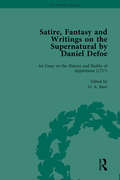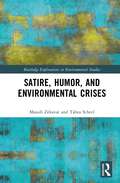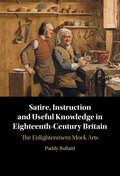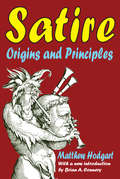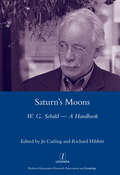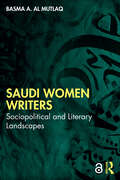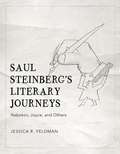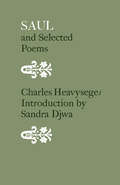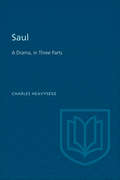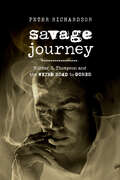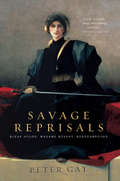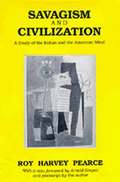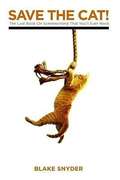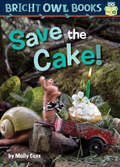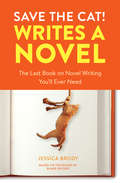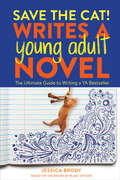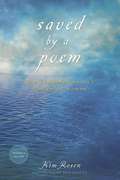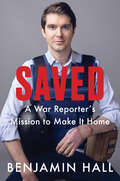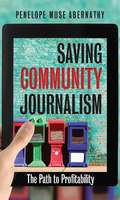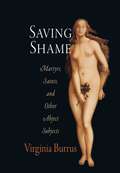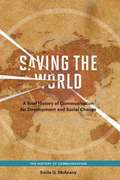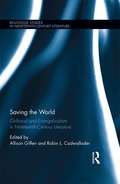- Table View
- List View
Satire, Fantasy and Writings on the Supernatural by Daniel Defoe, Part II vol 8 (The\pickering Masters Ser.)
by W R Owens P N FurbankThe publication of the 44-volume Works of Daniel Defoe continues with this collection of Defoe's satirical poetry and fantasy writings, and writings on the supernatural.
Satire, Humor, and Environmental Crises (Routledge Explorations in Environmental Studies)
by Tabea Scheel Massih ZekavatSatire, Humor, and Environmental Crises explores how satire and humor can be employed to address and mitigate ecological crises at individual and collective levels. Besides scientific and technological endeavors, solutions to ecological crises must entail social and communicative reform to persuade citizens, corporations, organizations, and policymakers to adopt more sustainable lifestyles and policies. This monograph reassesses environmental behavior and messaging and explores the promises of humorous and satiric communication therein. It draws upon a solid and interdisciplinary theoretical foundation to explicate the individual, social, and ecospheric determinants of behavior. Creative works of popular culture across various modes of expression, including The Simpsons, Last Week Tonight with John Oliver, and The New Yorker cartoons, are examined to illustrate the strong if underappreciated relationship between humor and the environment. This is followed by a discussion of the instruments and methodological subtleties involved in measuring the impacts of humor and satire in environmental advocacy for the purpose of conducting empirical research. More broadly, the book aspires to participate in urgent cultural and political discussions about how we can evaluate and intervene in the full diversity of environmental crises, engage a broad set of internal and external partners and stakeholders, and develop models for positive social and environmental transformations. This book will be of great interest to students and scholars interested in environmental humanities, communication science, psychology, and critical humor studies. It can further benefit environmental activists, policymakers, NGOs, and campaign organizers.
Satire, Instruction and Useful Knowledge in Eighteenth-Century Britain: The Enlightenment Mock Arts
by Paddy BullardLong before the Industrial Revolution was deplored by the Romantics or documented by the Victorians, eighteenth-century British writers were thinking deeply about the function of literature in an age of invention. They understood the significance of 'how-to' knowledge and mechanical expertise to their contemporaries. Their own framing of this knowledge, however, was invariably satirical, critical, and oblique. While others compiled encyclopaedias and manuals, they wrote 'mock arts'. This satirical sub-genre shaped (among other works) Swift's Gulliver's Travels, Sterne's Tristram Shandy, and Edgeworth's Belinda. Eighteenth-century satirists and poets submitted to a general paradox: the nature of human skilfulness obliged them to write in an indirect and unpractical way about the practical world. As a result, their explorations of mechanical expertise eschewed useable descriptions of the mechanical trades. They wrote instead a long and peculiar line of books that took apart the very idea of an instructional literature: the Enlightenment Mock Arts.
Satire: Origins and Principles
by Matthew HodgartSatire, according to Jonathan Swift, is a mirror where beholders generally discover everybody's face but their own. and over twenty-four centuries the mirror of satirical literature has taken on many shapes. Yet certain techniques recur continually, certain themes are timeless, and some targets are perennial. Politics (the mismanagement of men by other men) has always been a target of satire, as has the war between sexes.The universality of satire as a mode and creative impulse is demonstrated by the cross-cultural development of lampoon and travesty. Its deep roots and variety are shown by the persistence of allegory, fable, aphorism, and other literary subgenres. Hodgart analyzes satire at some of its most exuberant moments in Western literature, from Aristophanes to Brecht. His analysis is supplemented by a selection and discussion of prints and cartoons.Satire continues to help us make sense of the conventions that seem to have been almost genetically transmitted from their satiric ancestors to our digital contemporaries. This is especially evident in Hodgart's repeated references to satire's predilection for the ephemeral, for camouflaging itself among the everyday, for speaking to the moment, and thus for integrating itself as deeply as possible into society. Brian Connery's new introduction places Hodgart's analysis in its proper place in the development of twentieth-century criticism.
Satiric Advice on Women and Marriage: From Plautus to Chaucer
by Warren S. SmithScholars of classics and religion, mostly British or American, sample satiric attitudes about women and marriage written in Latin from about 200 BC through Walter Map in the 12th century, with two closing chapters on Chaucer writing in Middle English during the 14th. Among their topics are Roman education and Greek rhetorical thought on marriage, advice on sex by the self-defeating satirists, Jerome and the asceticization of satire, change and continuity in pagan thought and Christian invective on women and marriage from Antiquity to the Middle Ages, and antifeminism in the High Middle Ages. Annotation ©2004 Book News, Inc. , Portland, OR (booknews. com)
Saturn's Moons: A W.G Sebald Handbook
by Jo CatlingThe German novelist, poet and critic W. G. Sebald (1944-2001) has in recent years attracted a phenomenal international following for his evocative prose works such as Die Ausgewanderten (The Emigrants), Die Ringe des Saturn (The Rings of Saturn) and Austerlitz, spellbinding elegiac narratives which, through their deliberate blurring of genre boundaries and provocative use of photography, explore questions of Heimat and exile, memory and loss, history and natural history, art and nature. Saturn's Moons: a W. G. Sebald Handbook brings together in one volume a wealth of new critical and visual material on Sebald's life and works, covering the many facets and phases of his literary and academic careers -- as teacher, as scholar and critic, as colleague and as collaborator on translation. Lavishly illustrated, the Handbook also contains a number of rediscovered short pieces by W. G. Sebald, hitherto unpublished interviews, a catalogue of his library, and selected poems and tributes, as well as extensive primary and secondary bibliographies, details of audiovisual material and interviews, and a chronology of life and works. Drawing on a range of original sources from Sebald's Nachlass - the most important part of which is now held in the Deutsches Literaturarchiv Marbach - Saturn's Moons6g will be an invaluable sourcebook for future Sebald studies in English and German alike, complementing and augmenting recent critical works on subjects such as history, memory, modernity, reader response and the visual. The contributors include Mark Anderson, Anthea Bell, Ulrich von Buelow, Jo Catling, Michael Hulse, Florian Radvan, Uwe Schuette, Clive Scott, Richard Sheppard, Gordon Turner, Stephen Watts and Luke Williams. Jo Catling teaches in the School of Literature at the University of East Anglia and Richard Hibbitt in the Department of French at the University of Leeds.
Saudi Women Writers: Sociopolitical and Literary Landscapes
by Basma A. Al MutlaqSaudi Women Writers: Sociopolitical and Literary Landscapes details the achievements of Saudi women fiction writers from the 1960s up to the present day, many of whose works have yet to be published in English translation.This book explores how various Saudi women writers’ works reflect deep social, religious and political changes over several key phases: the secularism of the 1960s and 1970s; the 1980s religious revival, or saḥwa; the post-saḥwa period; and the era of globalization. Engaging with intersectional feminism, that studies women’s texts as a multifaceted space of identity, power and agency, with the capacity to critique, and possibly dismantle, traditional hierarchies, especially amidst evolving social, religious and political landscapes. By examining the works of Samira Khashugji, Qmasha al-Olayyan, Omima al-Khamis, Zaineb Hefny, Badriya al-Beshir, Raja al-Sanea, Saba al-Herz and Warda Abdul Malik, this book charts a fresh course in literary criticism, moving beyond restrictive and monolithic perspectives.Saudi Women Writers: Sociopolitical and Literary Landscapes is an important and unique text which will be of use to both students and scholars of Gender Studies, Literature, Middle Eastern Studies, and Politics.The Open Access version of this book, available at http://www.taylorfrancis.com, has been made available under a Creative Commons Attribution-Non Commercial-No Derivatives (CC BY-NC-ND) 4.0 license.
Saul Bellow: "I Was a Jew and an American and a Writer" (The Modern Jewish Experience)
by Gerald SorinSaul Bellow: "I Was a Jew and an American and a Writer" offers a fresh and original perspective on the life and works of Saul Bellow, the Nobel Prize winner in Literature in 1976. Author Gerald Sorin emphasizes Bellow's Jewish identity as fundamental to his being and the content and meaning of his fiction. Bellow's work from the 1940s to 2000, when he wrote his last novel at the age of 84, centers on the command in Deuteronomy to "Choose life" as distinct from nihilistic withdrawal and the defense of meaninglessness.Although Bellow disdained the label of "American Jewish Writer," Sorin conjectures that he was an outstanding representative of the classification. Bellow and the characters in his fiction not only choose life but also explore what it means to live a good life, however difficult that may be to define, and regardless of how much harder it is to achieve. For Sorin, Bellow realized that at least two obstacles stood in the way: the imperfection of the world and the frailty of the human pursuer.Saul Bellow: "I Was a Jew and an American and a Writer" provides a new and insightful narrative of the life and works of Saul Bellow. By using Bellow's deeply internalized Jewishness and his remarkable imagination and creativity as a lens, Sorin examines how he captured the shifting atmosphere of postwar American culture.
Saul Steinberg's Literary Journeys: Nabokov, Joyce, and Others
by Jessica R. FeldmanSaul Steinberg’s inimitable drawings, paintings, and assemblages enriched the New Yorker, gallery and museum shows, and his own books for more than half a century. Although the literary qualities of Steinberg’s work have often been noted in passing, critics and art historians have yet to fathom the specific ways in which Steinberg meant drawing not merely to resemble writing but to be itself a type of literary writing. Jessica R. Feldman's Saul Steinberg’s Literary Journeys, the first book-length critical study of Steinberg’s art and its relation to literature, explores his complex literary roots, particularly his affinities with modernist aesthetics and iconography. The Steinberg who emerges is an artist of far greater depth than has been previously recognized. Feldman begins her study with a consideration of Steinberg as a reader and writer, including a survey of his personal library. She explores the practice of modernist parody as the strongest affinity between Steinberg and the two authors he repeatedly claimed as his "teachers"—Vladimir Nabokov and James Joyce. Studying Steinberg’s art in tandem with readings of selected works by Nabokov and Joyce, Feldman explores fascinating bonds between Steinberg and these writers, from their tastes for parody and popular culture to their status as mythmakers, émigrés, and perpetual wanderers. Further, Feldman relates Steinberg’s uniquely literary art to a host of other authors, including Rimbaud, Baudelaire, Flaubert, Gogol, Tolstoy, and Defoe. Generously illustrated with the artist’s work and drawing on invaluable archival material from the Saul Steinberg Foundation, this innovative fusion of literary history and art history allows us to see anew Steinberg’s art.
Saul and Selected Poems: A Poem in Three Cantos
by Sandra Djwa Douglas Lochhead Charles HeavysegeSaul and Selected Poems is an original and useful introduction to the work and poetic personality of Charles Heavysege (1816-76), an important but currently neglected nineteenth-century Canadian writer. Heavysege was handicapped by a limited education and a lack of public support, yet nonetheless established himself in Great Britain and America as the 'leading intellect of [the] Dominion' in a period when native literature was scantily regarded. His struggle to express himself and to find an audience for his work mirrors the dilemma of the émigré writer of his time. Heavysege's work is related in this volume to the early nineteenth-century English revival of poetic drama, and seen in the context of the Canadian cultural milieu of the 1860s. Saul is a powerful presentation of the tormented soul caught in a world of order and universal degree. Its main interest is to be found in the psychological frankness - Saul's recognition of his demon resonates with the deeper implication of the recognition of the döppelgänger - and in passages of sinewy verse written with a directness that anticipates E.J. Pratt. The text of Saul and 'Jezebel,' selections from Jephthah's Daughter, an original commentary on the major poems, a bibliography, and a review of Heavysege criticism are all included in this volume. (Literature of Canada 19)
Saul: A Drama, in Three Parts (Second Edition)
by Douglas Lochhead Charles HeavysegeCharles Heavysege's chief and best-known work, the long-verse drama and tragedy Saul, was published in Montreal in 1857. Coventry Patmore, reviewing Saul in the North British Review, ranked it as the greatest English poem published outside Great Britain. Hawthorne, Emerson, and Longfellow were all enthusiastic in their praise, and the play went into three editions. Saul is a drama of 135 scenes containing the remarkable character of the fallen angel Malzah, who has been compared by critics to Shakespeare’s Caliban. Itis a powerful presentation of the tormented soul caught in a world of order and universal degree. Its main interest is to be found in the psychological frankness - Saul's recognition of his demon resonates with the deeper implication of the recognition of the döppelgänger - and in passages of sinewy verse written with a directness that anticipates E.J. Pratt.
Saussure’s Linguistics, Structuralism, and Phenomenology: The Course in General Linguistics after a Century
by Beata StawarskaThis is the first English-language guidebook geared at an interdisciplinary audience that reflects relevant scholarly developments related to the legacy and legitimacy of Ferdinand de Saussure's Course in General Linguistics (1916) today. It critically assesses the relation between materials from the Course and from the linguist’s Nachlass (works unpublished or even unknown at Saussure’s death, some of them recently discovered). This book pays close attention to the set of oppositional pairings: the signifier and the signified, la langue (language system) and la parole (speech), and synchrony and diachrony, that became the hallmark of structuralism across the humanities. Sometimes referred to as the “Saussurean doctrine,” this hierarchical conceptual apparatus becomes revised in favor of a horizontal set of relations, which co-involves speaking subjects and linguistic structures. This book documents the continued relevance of Saussure’s linguistics in the 21st Century, and it sheds light on its legacy within structuralism and phenomenology. The reader can consult the book on its own, or in tandem with the 1916 Course.
Savage Journey: Hunter S. Thompson and the Weird Road to Gonzo
by Peter RichardsonA superbly crafted study of Hunter S. Thompson’s literary formation, achievement, and continuing relevance. Savage Journey is a "supremely crafted" study of Hunter S. Thompson's literary formation and achievement. Focusing on Thompson's influences, development, and unique model of authorship, Savage Journey argues that his literary formation was largely a San Francisco story. During the 1960s, Thompson rode with the Hell's Angels, explored the San Francisco counterculture, and met talented editors who shared his dissatisfaction with mainstream journalism. Author Peter Richardson traces Thompson's transition during this time from New Journalist to cofounder of Gonzo journalism. He also endorses Thompson's later claim that he was one of the best writers using the English language as both a musical instrument and a political weapon. Although Thompson's political commentary was often hyperbolic, Richardson shows that much of it was also prophetic. Fifty years after the publication of Fear and Loathing in Las Vegas, and more than a decade after his death, Thompson's celebrity continues to obscure his literary achievement. This book refocuses our understanding of that achievement by mapping Thompson's influences, probing the development of his signature style, and tracing the reception of his major works. It concludes that Thompson was not only a gifted journalist, satirist, and media critic, but also the most distinctive American voice in the second half of the twentieth century.
Savage Reprisals: Bleak House, Madame Bovary, Buddenbrooks
by Peter GayA revelatory work that examines the intricate relationship between history and literature, truth and fiction--with some surprising conclusions. Focusing on three literary masterpieces--Charles Dickens's Bleak House (1853), Gustave Flaubert's Madame Bovary (1857), and Thomas Mann's Buddenbrooks (1901)--Peter Gay, a leading cultural historian, demonstrates that there is more than one way to read a novel. Typically, readers believe that fiction, especially the Realist novels that dominated Western culture for most of the nineteenth century and beyond, is based on historical truth and that great novels possess a documentary value. That trust, Gay brilliantly shows, is misplaced; novels take their own path to reality. Using Dickens, Flaubert, and Mann as his examples, Gay explores their world, their craftsmanship, and their minds. In the process, he discovers that all three share one overriding quality: a resentment and rage against the society that sustains the novel itself. Using their stylish writing as a form of revenge, they deal out savage reprisals, which have become part of our Western literary canon. A New York Times Notable Book and a Best Book of 2002.
Savagism and Civilization: A Study of the Indian and the American Mind
by Roy Harvey PearceFirst published in 1953, revised in 1964, and presented here with a new foreword by Arnold Krupat and new postscript by the author, Roy Harvey Pearce's "Savagism and Civilization" is a classic in the genre of history of ideas. Examining the political pamphlets, missionaries' reports, anthropologists' accounts, and the drama, poetry, and novels of the 18th and early 19th centuries, Professor Pearce traces the conflict between the idea of the noble savage and the will to Christianize the heathen and appropriate their land, which ended with the near extermination of Native American culture.
Save The Cat!: The Last Book on Screenwriting You'll Ever Need
by Blake SnyderThis fun-to-read insiders guide reveals the truth about what it takes to craft and sell a script. After a lucrative 20-year career that includes working with some of the top producers in Hollywood, Snyder opens up his notebooks and shows how he creates, develops, beats out and writes a screenplay that accommodates the business practices of the script buyers.
Save the Cake! (Bright Owl Books)
by Molly CoxeKate and Nate baked a cake. Can they keep it safe from Snake? This fun photographic easy-to-read story features the long "a" vowel sound. Kane Press's new series of super simple easy-to-reads, Bright Owl Books, adds Molly Coxe's five fun photographic long vowel stories, which are each only around 100–200 words. Molly Coxe's stories help kids learn to read by teaching the basic building blocks of reading—vowel sounds. With a note to parents and teachers at the beginning and story starters at the end, these books give kids the perfect start on educational success. Bright Owl Books make bright owl readers!
Save the Cat! Writes a Novel: The Last Book On Novel Writing You'll Ever Need (Save the Cat!)
by Jessica BrodyThe first novel-writing guide from the best-selling Save the Cat! story-structure series, which reveals the 15 essential plot points needed to make any novel a success.Novelist Jessica Brody presents a comprehensive story-structure guide for novelists that applies the famed Save the Cat! screenwriting methodology to the world of novel writing. Revealing the 15 "beats" (plot points) that comprise a successful story--from the opening image to the finale--this book lays out the Ten Story Genres (Monster in the House; Whydunit; Dude with a Problem) alongside quirky, original insights (Save the Cat; Shard of Glass) to help novelists craft a plot that will captivate--and a novel that will sell.
Save the Cat! Writes a Young Adult Novel: The Ultimate Guide to Writing a YA Bestseller (Save the Cat!)
by Jessica BrodyAn indispensable guide in the bestselling Save the Cat! story structure series that reveals the 15 essential plot points needed to make any young adult novel a success, from an accomplished novelist and the author of Save the Cat! Writes a Novel.In Save the Cat! Writes a Young Adult Novel, prolific author and story coach Jessica Brody presents a comprehensive story structure guide for anyone who wants to write a young adult novel by applying the famed Save the Cat! screenwriting methodology to the world of YA fiction. In this book, you will learn: • The fifteen &“beats&” (or plot points) that are necessary for crafting a successful story with a compelling character arc—including the Opening Image, Catalyst, Fun and Games, Bad Guys Close In, Dark Night of the Soul, and Finale• The ten universal story genres that will help you drill into what makes your type of story work, including those most commonly found in young adult novels like Rites of Passage, Superhero, Buddy Love, Institutionalized, and Golden Fleece• Quirky, original insights and writing tips like &“Save the Cat,&” the &“Shard of Glass,&” and the &“Dark Night Epiphany,&” that help you craft a story that will thrill and captivate teen readersFilled with practical advice, easy-to-follow templates, and &“beat sheets&” analyzing the structure of popular young adult novels such as Leigh Bardugo&’s Six of Crows, John Green&’s The Fault in Our Stars, and Lois Lowry&’s The Giver, this book is the ultimate reference for anyone who&’s ever dreamed of writing their own young adult bestseller.
Saved by a Poem: The Transformative Power of Words
by Kim RosenCan someone really be saved by a poem? In Kim Rosen's book, the answer is a resounding "Yes!" Poetry, the most ancient form of prayer, is a necessary medicine for our times: a companion through difficulty; a guide when we are lost; a salve when we are wounded; and a conduit to an inner source of joy, freedom, and insight. Whether you are a lover of poetry or have yet to discover its power, Rosen offers a new way to experience a poem. She encourages you to feel the poem as you might an affirmation or sacred text, which can align every level of your being. In an uncertain world, Saved by a Poem is an emphatic call to cultivate the ever-renewable resources of the heart. Through poetry, the unspeakable can be spoken, the unendurable endured, and the miraculous shared. Weaving teaching, story, verse, and memoir, Rosen guides you to find a poem that speaks to you so you can take it into your life and become a voice for its wisdom in the world. Inspirational CD Included! Featuring the voices of well-known authors reading a favorite poem and discussing its personal significance: Joan Borysenko, Andrew Harvey, Jane Hirshfield, Marie Howe, Grace Yi-Nan Howe, Robert Holden, Stanley Kunitz, Elizabeth Lesser, Thomas Moore, Christiane Northrup, Cheryl Richardson, Kim Rosen, and Geneen Roth.
Saved: A War Reporter's Mission to Make It Home
by Benjamin HallWhen veteran war reporter Benjamin Hall woke up in Kyiv on the morning of March 14, 2022, he had no idea that, within hours, Russian bombs would nearly end his life. As a journalist for Fox News, Hall had worked in dangerous war zones like Syria and Afghanistan, but with three young daughters at home, life on the edge was supposed to be a thing of the past. Yet when Russia viciously attacked Ukraine in February 2022, Hall quickly volunteered to go. A few weeks later, while on assignment, Hall and his crew were blown up in a Russian strike. With Hall himself gravely injured and stuck in Kyiv, it was unclear if he would make it out alive. <p><p>This is the story of how he survived—a story that continues to this day. For the first time, Hall shares his experience in full—from his ground-level view of the war to his dramatic rescue to his arduous, and ongoing, recovery. Going inside the events that have permanently transformed him, Hall recalls his time at the front lines of our world’s conflicts, exploring how his struggle to step away from war reporting led him back one perilous last time. Featuring nail-biting accounts from the many people across multiple countries who banded together to get him to safety, Hall offers a stunning look at complex teamwork and heartfelt perseverance that turned his life into a mission. <p><p>Through it all, Hall’s spirit has remained undaunted, buoyed by that remarkable corps of people from around the world whose collective determination ensured his survival. <p><p>Evocative, harrowing, and deeply moving, Saved is a powerful memoir of family and friends, of life and healing, and of how to respond when you are tested in ways you never thought possible.Benjamin Hall’s memoir includes a 16-page color photo insert. <p> <b>New York Times Bestseller</b>
Saving Community Journalism
by Penelope Muse AbernathyAmerica's community newspapers have entered an age of disruption. Towns and cities continue to need the journalism and advertising so essential to nurturing local identity and connection among citizens. But as the business of newspaper publishing collides with the digital revolution, and as technology redefines consumer habits and the very notion of community, how can newspapers survive and thrive? In Saving Community Journalism, veteran media executive Penelope Muse Abernathy draws on cutting-edge research and analysis to reveal pathways to transformation and long-term profitability. Offering practical guidance for editors and publishers, Abernathy shows how newspapers can build community online and identify new opportunities to generate revenue. Examining experiences at a wide variety of community papers--from a 7,000-circulation weekly in West Virginia to a 50,000-circulation daily in California and a 150,000-circulation Spanish-language weekly in the heart of Chicago--Saving Community Journalism is designed to help journalists and media-industry managers create and implement new strategies that will allow them to prosper in the twenty-first century. Abernathy's findings will interest everyone with a stake in the health and survival of local media.
Saving Shame
by Virginia BurrusVirginia Burrus explores one of the strongest and most disturbing aspects of the Christian tradition, its excessive preoccupation with shame. While Christianity has frequently been implicated in the conversion of ancient Mediterranean cultures from shame- to guilt-based, and thus in the emergence of the modern West's emphasis on guilt, Burrus seeks to recuperate the importance of shame for Christian culture. Focusing on late antiquity, she explores a range of fascinating phenomena, from the flamboyant performances of martyrs to the imagined abjection of Christ, from the self-humiliating disciplines of ascetics to the intimate disclosures of Augustine.Burrus argues that Christianity innovated less by replacing shame with guilt than by embracing shame. Indeed, the ancient Christians sacrificed honor but laid claim to their own shame with great energy, at once intensifying and transforming it. Public spectacles of martyrdom became the most visible means through which vulnerability to shame was converted into a defiant witness of identity; this was also where the sacrificial death of the self exemplified by Christ's crucifixion was most explicitly appropriated by his followers. Shame showed a more private face as well, as Burrus demonstrates. The ambivalent lure of fleshly corruptibility was explored in the theological imaginary of incarnational Christology. It was further embodied in the transgressive disciplines of saints who plumbed the depths of humiliation. Eventually, with the advent of literary and monastic confessional practices, the shame of sin's inexhaustibility made itself heard in the revelations of testimonial discourse.In conversation with an eclectic constellation of theorists, Burrus interweaves her historical argument with theological, psychological, and ethical reflections. She proposes, finally, that early Christian texts may have much to teach us about the secrets of shame that lie at the heart of our capacity for humility, courage, and transformative love.
Saving the World: A Brief History of Communication for Devleopment and Social Change
by Emile G. McananyThis far-reaching and long overdue chronicle of communication for development from a leading scholar in the field presents in-depth policy analyses to outline a vision for how communication technologies can impact social change and improve human lives. Drawing on the pioneering works of Daniel Lerner, Everett Rogers, and Wilbur Schramm as well as his own personal experiences in the field, Emile G. McAnany builds a new, historically cognizant paradigm for the future that supplements technology with social entrepreneurship. McAnany summarizes the history of the field of communication for development and social change from Truman's Marshall Plan for the Third World to the United Nations' Millennium Development Goals. Part history and part policy analysis, Saving the World argues that the communication field can renew its role in development by recognizing large aid-giving institutions have a difficult time promoting genuine transformation. McAnany suggests an agenda for improving and strengthening the work of academics, policy makers, development funders, and any others who use communication in all of its forms to foster social change.
Saving the World: Girlhood and Evangelicalism in Nineteenth-Century Literature (Routledge Studies in Nineteenth Century Literature #1)
by Allison Giffen Robin L. CadwalladerThis book makes a significant contribution to the burgeoning field of childhood studies in nineteenth-century literature and culture by drawing on the intersecting fields of girlhood, evangelicalism, and reform to investigate texts written in North America about girls, for girls, and by girls. Responding both to the intellectual excitement generated by the rise of girlhood studies, as well as to the call by recent scholars to recognize the significance of religion as a meaningful category in the study of nineteenth-century literature and culture, this collection locates evangelicalism at the center of its inquiry into girlhood. Contributors draw on a wide range of texts, including canonical literature by Harriet Beecher Stowe, Susan Warner, and Elizabeth Stuart Phelps, and overlooked archives such as US Methodist Sunday School fiction, children’s missionary periodicals, and the Christian Recorder, the flagship newspaper of the African Methodist Episcopal (AME) Church. These essays investigate representations of girlhood that engage, codify, and critique normative Protestant constructions of girlhood. Contributors examine girlhood in the context of reform, revealing the ways in which Protestantism at once constrained and enabled female agency. Drawing on a range of critical perspectives, including African American Studies, Disability Studies, Gender Studies, and Material Culture Studies, this volume enriches our understanding of nineteenth-century childhood by focusing on the particularities of girlhood, expanding it beyond that of the white able-bodied middle-class girl and attending to the intersectionality of identity and religion.
